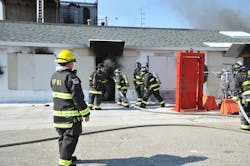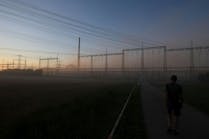PPE Supplement: Research Shines a Light
Download the full PDF of the supplement here.
View Firehouse’s collection of supplements and special content at firehouse.com/special-content.
Firefighters face multiple dangers in performing their public safety mission. However, statistics reveal that the greatest danger firefighters face is the body’s response to firefighting and the exposures associated with it. Most duty-related fatalities are due to sudden cardiac events, and each year far too many firefighters are diagnosed with occupational-related cancer.
Our research agenda at the University of Illinois Fire Service Institute (IFSI) and Skidmore College has long focused on the physiological strain associated with firefighting, and understanding the influence of PPE on how the human body responds has been a major component of that research.
Balancing act
PPE was originally designed to protect against water. But, in more recent history, the primary function of PPE, especially bunker gear, has been to protect against thermal injuries. It is clear that PPE is absolutely necessary to protect firefighters; it guards against multiple hazards, including thermal insult, abrasions, puncture, and chemical exposure. However, PPE also adds a significant burden to the wearer, especially in terms of the weight, which increases work, and the thermal properties, which can escalate heat stress. PPE can also negatively affect a firefighter’s range of motion and how they move throughout the fireground (or any response where bunker gear is worn).
PPE manufacturers have long sought to increase the protection provided by PPE while limiting this burden. This has been a careful balancing act, as increasing performance on one end of this scale can also have adverse effects on the other side. Recently, with increasing awareness of the risks associated with chemical exposures, there is new emphasis on modifying PPE to provide additional protection. Any changes to PPE must be balanced against the aforementioned factors that can interfere with job functions and increase heat stress.
Investigating exposures
At the IFSI, we have recently initiated a series of studies aimed at better understanding the risk of chemical exposures on cardiovascular health and cancer risk, and identifying the role that PPE plays in providing protection from chemical exposure. The “Firefighter Chemical Exposure and Cardiac Strain Research” projects address the two major health threats that firefighters face in a comprehensive way.
In 2015, we brought together five major research teams—IFSI, UL, NIOSH and academic researchers from Skidmore College and University of Illinois Chicago—to systematically investigate the exposures that firefighters face during typical scenarios on today’s fireground. We instrumented a ranch-style home with common household furnishings and set fires in two back bedrooms. On different days we had firefighters extinguish the fires using either an interior focused attack in which they entered the front door and advanced the line to the fire in the bedrooms, or a transitional attack (initial knock down from the window before entering the front door). In coordination with fire attack, additional crewmembers performed search and rescue, ventilation, deployed ladders, operated the pump and managed the incident.
As part of the research, we monitored heat, gas and particulate matter in the air; measured contamination on turnout gear and on the skin; and monitored biological uptake of chemicals by collecting blood, breath and urine of firefighters. With these scenarios, we are now able to analyze our data to investigate the effect of tactics on environmental conditions affecting firefighters and potential victims, and how tactics and job assignments relate to firefighters’ exposures and physiological responses.
In 2016, the team reconvened and extended the research to investigate the effects of different training situations on the same environmental factors, chemical exposures, and biological and physiological measures. In this experiment, we compared training fires in a metal container that contained theatrical smoke and digital fire simulation (no heat), a metal container with engineered wood (OSB), and a concrete building with straw and pallets.
The series of research studies has been critical to help us better characterize the cardiovascular and thermal strain associated with firefighting and understand the risks posed by those changes. By measuring multiple physiological factors, such as platelet function, coagulation, vascular measures and cardiac measures, we can better understand potential mechanisms by which the cardiovascular strain of firefighting is associated with sudden cardiac events during emergency operations. And by better describing the chemical exposures during firefighting—in the air, on gear, and on the skin, and what passes into the body—we can begin to better understand the mechanisms by which fireground exposures increase firefighters’ risk for cancer.
While we don’t have all answers from our research—and much more detail will be forthcoming shortly—we know enough to encourage firefighters to:
- Maintain a high level of fitness
- Get medical evaluations that include screening for cardiovascular disease and cancer
- Aggressively manage cardiovascular disease risk factors
- Wear respiratory protection from initial attack through overhaul
- Avoid the smoke plume and diesel exhaust and/or wear respiratory protection while on the fireground
- Use good judgment and protect themselves from dermal exposures, including washing gear, taking a shower and ensuring that they employ good hygiene, such as using body wipes to clean hands and face/neck on scene
- Apply water to the fire rapidly, and train on the application of a coordinated attack for successful response.
More to come
These studies include multiple partners, incorporate realistic scenarios that firefighters routinely encounter, and benefit from the involvement and commitment of firefighters from across the country. While substantially more research is needed, these studies will be instrumental in informing PPE development, design and use, as well as guiding the development of standard operating guidelines (SOGs).
To learn more details on these studies, visit: https://fsi.illinois.edu/documents/research/CardioChemRisksModernFF_InterimReport2016.pdf.
Sidebar: Integrated Research & PPE Development
“There is obviously a really significant big picture issue in the fire service today around health and wellness. The conversation started about cardiac events in the fire service and LODDs, and in the past few years, the awareness of cancer in the fire service has risen in a major way. With the overview of the big problems, we can get to what really is the voice of the customer and what it is that firefighters are really looking for when they think about PPE.
When you’re doing an athletic activity—in this case, as a tactical athlete—you’re doing high aerobic activity in a short but intense period of time. You’re doing things like climbing 14 flights of stairs and carrying 80 pounds of equipment and pulling hose. By making that turnout gear less restrictive, it takes less work to do your job, so you’re not fighting the gear. Just reducing that workload has a direct consequence in terms of lowering core body temperature, which is really your physiological response to this work. Everything we can do to make it easier translates into less cardiovascular strain and makes it more efficient for the firefighter to do their job.
For many years, we’ve been involved as the industry partner in research projects with organizations like IFSI, Skidmore College, UL and NIOSH to really try and understand the exposures to carcinogens. After conducting multiple burns involving various aspects of firefighting work, as well as training evolutions, we are left with several questions: What’s the exposure for the firefighter during fire suppression? What’s getting on the gear? What’s off-gassing from the gear?
All of that information is critically important to categorize the problem and for us to engineer a solution. How can we reduce the egress of smoke inside the garment? We are identifying the contaminants from the smoke that are actually getting on the firefighter or getting in their body to understand what it is that we’re trying to filter out—is it gas, is it particulates, is it both? What’s the chemical composition, and how does that impact how we can develop materials and fabric and design in order to be able to solve some of those problems and reduce the exposure?
Problem-solving involves the user at the beginning, to understand what the problem is to be solved and really get their input in terms of what their experience has been like. And then in the process, we can go through not only the research part, but also do some iterations about suggested solutions and put those solutions back out to the firefighter for them to test and validate—and they usually come up with suggestions as to what needs to happen to make it work better for them. So it’s a process where the end-users need to be involved throughout, from the beginning through the validation process, and then ultimately at the end we need to go through and tackle new problems to create the best gear.”
— Mark Mordecai, director of business development, Globe
Dr. Denise Smith
Dr. Denise Smith is a professor at Skidmore College and a research scientist at the Illinois Fire Service Institute (IFSI). She conducts research on the heat stress and cardiovascular strain associated with firefighting, pathoanatomic cause of firefighter fatalities, and strategies to increase performance and decrease cardiovascular events in the fire service.
Dr. Kenneth Fent
Dr. Kenneth Fent is a research industrial hygienist at the National Institute for Occupational Safety and Health (NIOSH). Much of his research has focused on characterizing firefighters’ exposures to chemical agents, including carcinogens, and evaluating the effectiveness of practices intended to reduce exposures.
Stephen Kerber
Stephen Kerber is the director of the UL Firefighter Safety Research Institute (FSRI). He has led fire service research and education in the areas of ventilation, structural collapse and fire dynamics.






